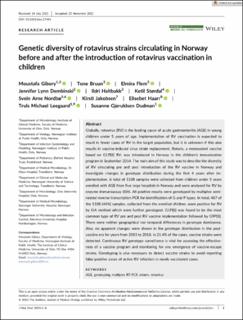| dc.contributor.author | Gibory, Moustafa | |
| dc.contributor.author | Bruun, Tone | |
| dc.contributor.author | Flem, Elmira | |
| dc.contributor.author | Dembinski, Jennifer Lynn | |
| dc.contributor.author | Haltbakk, Ildri | |
| dc.contributor.author | Størdal, Ketil | |
| dc.contributor.author | Nordbø, Svein Arne | |
| dc.contributor.author | Jakobsen, Kirsti | |
| dc.contributor.author | Haarr, Elisebet | |
| dc.contributor.author | Leegaard, Truls Michael | |
| dc.contributor.author | Dudman, Susanne Gjeruldsen | |
| dc.date.accessioned | 2022-02-04T08:13:02Z | |
| dc.date.available | 2022-02-04T08:13:02Z | |
| dc.date.created | 2021-12-06T15:01:04Z | |
| dc.date.issued | 2021 | |
| dc.identifier.citation | Journal of Medical Virology. 2021, . | en_US |
| dc.identifier.issn | 0146-6615 | |
| dc.identifier.uri | https://hdl.handle.net/11250/2977035 | |
| dc.description.abstract | Globally, rotavirus (RV) is the leading cause of acute gastroenteritis (AGE) in young children under 5 years of age. Implementation of RV vaccination is expected to result in fewer cases of RV in the target population, but it is unknown if this also results in vaccine-induced virus strain replacement. Rotarix, a monovalent vaccine based on G1P[8] RV, was introduced in Norway in the children's immunization program in September 2014. The main aim of this study was to describe the diversity of RV circulating pre and post introduction of the RV vaccine in Norway and investigate changes in genotype distribution during the first 4 years after implementation. A total of 1108 samples were collected from children under 5 years enrolled with AGE from five large hospitals in Norway and were analyzed for RV by enzyme immunoassay (EIA). All positive results were genotyped by multiplex semi-nested reverse transcription PCR for identification of G and P types. In total, 487 of the 1108 (44%) samples, collected from the enrolled children, were positive for RV by EIA method which were further genotyped. G1P[8] was found to be the most common type of RV pre and post RV vaccine implementation followed by G9P[8]. There were neither geographical nor temporal differences in genotype dominance. Also, no apparent changes were shown in the genotype distribution in the postvaccine era for years from 2015 to 2018. In 21.4% of the cases, vaccine strains were detected. Continuous RV genotype surveillance is vital for assessing the effectiveness of a vaccine program and monitoring for any emergence of vaccine-escape strains. Genotyping is also necessary to detect vaccine strains to avoid reporting false-positive cases of active RV infection in newly vaccinated cases. | en_US |
| dc.language.iso | eng | en_US |
| dc.publisher | Wiley | en_US |
| dc.rights | Attribution-NonCommercial-NoDerivatives 4.0 Internasjonal | * |
| dc.rights.uri | http://creativecommons.org/licenses/by-nc-nd/4.0/deed.no | * |
| dc.title | Genetic diversity of rotavirus strains circulating in Norway before and after the introduction of rotavirus vaccination in children | en_US |
| dc.type | Peer reviewed | en_US |
| dc.type | Journal article | en_US |
| dc.description.version | publishedVersion | en_US |
| dc.source.pagenumber | 8 | en_US |
| dc.source.journal | Journal of Medical Virology | en_US |
| dc.identifier.doi | 10.1002/jmv.27484 | |
| dc.identifier.cristin | 1965169 | |
| cristin.ispublished | true | |
| cristin.fulltext | original | |
| cristin.qualitycode | 1 | |

